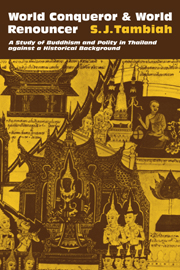 World Conqueror and World Renouncer
World Conqueror and World Renouncer Book contents
- Frontmatter
- Contents
- Acknowledgments
- PART ONE
- 1 Introduction: Reconstructing a Journey
- 2 From Rajadharma (the King's “Whole Duty”) to Dharmaraja (the “Righteous Ruler”)
- 3 The Brahmanical Theory of Society and Kingship
- 4 The Early Buddhist Conception of World Process, Dharma, and Kingship
- 5 Asoka Maurya: The Paradigm
- 6 Thai Kingship and Polity in Historical Perspective
- 7 The Galactic Polity
- 8 The Kingdom of Ayutthaya: Design and Process
- 9 Asokan and Sinhalese Traditions Concerning the Purification of the Sangha
- 10 The Sangha and the Polity: From Ayutthaya to Bangkok
- 11 The Nineteenth-Century Achievements of Religion and Sangha
- 12 The Sangha Acts of 1902, 1941, and 1963
- PART TWO
- Bibliography
- Index
6 - Thai Kingship and Polity in Historical Perspective
Published online by Cambridge University Press: 10 November 2010
- Frontmatter
- Contents
- Acknowledgments
- PART ONE
- 1 Introduction: Reconstructing a Journey
- 2 From Rajadharma (the King's “Whole Duty”) to Dharmaraja (the “Righteous Ruler”)
- 3 The Brahmanical Theory of Society and Kingship
- 4 The Early Buddhist Conception of World Process, Dharma, and Kingship
- 5 Asoka Maurya: The Paradigm
- 6 Thai Kingship and Polity in Historical Perspective
- 7 The Galactic Polity
- 8 The Kingdom of Ayutthaya: Design and Process
- 9 Asokan and Sinhalese Traditions Concerning the Purification of the Sangha
- 10 The Sangha and the Polity: From Ayutthaya to Bangkok
- 11 The Nineteenth-Century Achievements of Religion and Sangha
- 12 The Sangha Acts of 1902, 1941, and 1963
- PART TWO
- Bibliography
- Index
Summary
A fundamental and striking feature that Sinhalese or Burmese or Thai concepts of Buddhist kingship stridently assert is conspicuously missing in the Asokan inscriptions. Asoka never once referred to himself in the inscriptions as a bodhisattva. As we have seen, Asoka's objective of attaining to heaven through his advocacy of dharma cannot be mistaken for the universal liberation or messianic promise of a bodhisattva.
This bodhisattva ideal of the king as a cosmic liberator with its attendant cosmological representation in palace architecture and in calendrical rites, an ideal that also wove in the soteriological claims of a wheel-wielding cakkavatti who would deliver his subjects from immediate woes, is decidedly a later development removed in time from the Asokan era.
The precise description of the transplantation of Buddhist (and Hindu) ideas of kingship and polity outside India, and the manner of their taking root and forming a distinctive configuration in Sinhalese, Mon, Khmer, Burmese, or Thai soil, as the case may be, is difficult to describe for lack of definitive evidence. Yet one's posture on this issue has consequences for arranging whatever facts are known into meaningful patterns.
In trying to state one's own position and perspective, it is perhaps well to begin with a comment by Mus:
Throughout the general context of Monsoon Asia, the threshold will be found at the level where the Sovereignty of a centralized state, with its legal apparatus, comes into contact with the dense nexus of local, “cadastral” cults and unwritten practice. […]
- Type
- Chapter
- Information
- World Conqueror and World RenouncerA Study of Buddhism and Polity in Thailand against a Historical Background, pp. 73 - 101Publisher: Cambridge University PressPrint publication year: 1976


